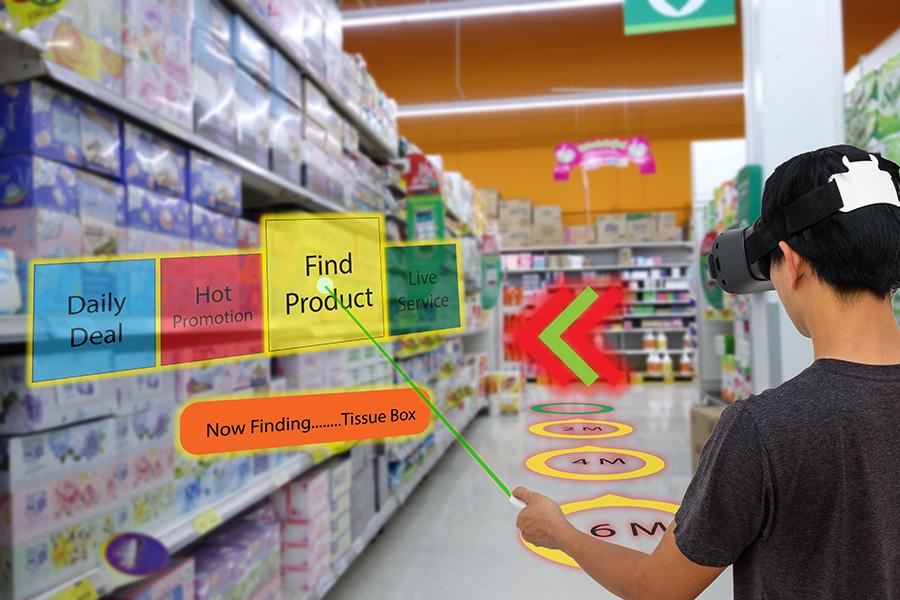Integrated Retail Marketing Communication | Advance Video Course
in Marketing ManagementWhat you will learn?
How to build a strong retail brand identity
Strategies for positioning retail brands effectively
The impact of digital & traditional advertising in retail
Practical ways to improve customer engagement & loyalty
The impact of digital & traditional advertising in retail
How to measure advertising effectiveness and ROI
About this course
About this Course
This comprehensive online course covers the fundamentals of retail marketing communication, including branding, positioning, advertising, and promotions to help businesses drive customer engagement and increase sales.
Course Overview
• Learn how to create a powerful retail brand identity
• Master the art of positioning your retail brand for a competitive advantage
• Explore traditional & digital advertising strategies for retail success
• Understand the importance of cooperative advertising & in-store promotions
• Develop an omnichannel marketing strategy for retail growth
Course Curriculum / Modules
1. Introduction to Retail Marketing Communication
2. Branding the Store – Fundamentals & Importance
3. Creating a Unique Retail Brand Identity
4. Positioning the Retail Brand – Key Strategies
5. Customer Perception & Retail Brand Image
6. Crafting a Retail Brand Message & Voice
7. Introduction to Retail Advertising
8. Digital Advertising for Retail Stores
9. Traditional Retail Advertising Strategies
10. Cooperative Advertising & Instore Advertising
11. Instore Advertising & Promotions
12. Omnichannel Retail Advertising Strategies
13. Personalized Marketing & Customer Engagement
14. Seasonal & Event-Based Retail Advertising
15. Budgeting & ROI Measurement in Retail Advertising
16. Leveraging Social Media for Retail Branding
17. Customer Psychology & Persuasive Communication
18. Crisis Communication & Reputation Management in Retail
19. Future Trends in Retail Marketing Communication
20. Capstone Project: Developing a Retail Marketing Plan
What You Will Learn
✔️ How to build a strong retail brand identity
✔️ Strategies for positioning retail brands effectively
✔️ The impact of digital & traditional advertising in retail
✔️ Practical ways to improve customer engagement & loyalty
✔️ How to measure advertising effectiveness and ROI
Learning Objective
• Develop comprehensive retail marketing strategies
• Implement branding & advertising techniques effectively
• Create customer-centric marketing campaigns
• Understand customer psychology & buying behavior
• Use data-driven marketing insights for retail growth
Course Features & Benefits
✅ 100% Self-Paced Online Learning
✅ Real-World Case Studies & Practical Examples
✅ Downloadable Resources & Templates
✅ Access to Expert Webinars & Q&A Sessions
✅ Industry-Relevant Curriculum
Who This Course is For
👨💼 Retail Professionals & Store Owners
🎯 Marketing & Sales Executives
📈 Business Owners & Entrepreneurs
📚 Students & Fresh Graduates in Marketing
Skills Covered
🔹 Retail Branding & Positioning
🔹 Digital & Traditional Retail Advertising
🔹 Customer Engagement & Loyalty Programs
🔹 Persuasive Communication & Psychology
🔹 Marketing Analytics & ROI Measurement
Special Benefits to Students for Enrolling Now
🎁 Lifetime Access to Course Materials
🎁 Exclusive Access to Case Studies & Industry Insights
🎁 Personalized Career Guidance & Support
Exclusive Complimentary Benefit: One-on-One Expert Interaction
💡 Schedule a one-on-one session with an industry expert to discuss real-world marketing challenges and receive personalized advice!
Course Certificate Advantage
📜 Earn a recognized certification upon course completion
🎖️ Showcase your expertise on LinkedIn & Resume
🚀 Enhance your career prospects in retail & marketing sectors
Instructor Bio
👨🏫 Led by industry professionals with years of experience in retail marketing, branding, and communication strategies
Books & Reference
📖 Recommended reading list includes top books & research papers on retail branding & marketing communication
Top Indian Companies Hiring with These Certifications & Skillset
🏢 Retail & E-commerce Giants: Amazon, Flipkart, Reliance Retail
🏢 FMCG & Consumer Goods Brands: Hindustan Unilever, ITC, P&G
🏢 Luxury & Lifestyle Brands: Titan, Tanishq, Aditya Birla Fashion
🏢 Shopping Malls & Retail Chains: DLF, Phoenix Malls, Shoppers Stop
Related Courses
FAQ
Comments (0)
Summary of Benefits of Branding for Retailers and Customers
Store Positioning
Attributes that influence Store Positioning
Objectives, Functions and Types of Retail Advertising
Let's summarize the Key steps in Retail Advertising that we learnt.
Decide on the Advertising Budget: Retailers can use various methods to determine the budget such as a) Percentage of anticipated sales, b) Competitive parity, c) Affordability method and d) Objective based budgeting
Define the Target Audience and Store Profile: In this, retailers identify their audience based on demographics, lifestyle, and preferences. They also evaluate their store’s merchandise, image, and competitive positioning to ensure the advertising resonates with the audience.
Plan the Media and Craft the Message: Media planning involves selecting the timing, frequency, and appropriate media channels, such as newspapers, radio, outdoor displays, or digital platforms
Measure the Effectiveness: Evaluating campaign performance is crucial. It involves comparing metrics like footfalls, brand awareness, and customer preferences with the advertising objectives
Without following the above structured process, the advertising campaigns will be ineffective.
A very important part of Retail Advertising is crafting a retail advertising message. It is a creative process that involves emotional and rational appeals.
In the next lesson, we will delve into the importance of such crafting messages, the role of the AIDA model, and how elements such as store positioning, target audience, and product selection shape effective retail advertising.
Crafting the Retail Advertising Message
Selecting the right media is crucial in retail marketing. Retailers must strategically choose from various media options to align with their store’s positioning and target customer profiles.
The following are different media options available to retailers and their unique merits:
Print Media: Print media includes magazines, newspapers, local tabloids, and yellow pages. This traditional medium is suitable for targeting literate and information-seeking audiences. Retailers like FabIndia use print media to showcase their ethnic collections through full-page ads in lifestyle magazines. This advertising reinforces the brand’s association with culture and sophistication.
Outdoor Media: Outdoor advertising includes hoardings, street signs, bus panels, balloons, and more. This medium is ideal for creating a strong visual presence and brand recall. For example, Tanishq leverages hoardings during festive seasons to highlight its latest jewellery collections strategically placed in high-traffic urban areas.
Radio: With the resurgence of FM channels, radio has become a powerful local audio medium. It’s highly effective for city-wide campaigns targeting diverse demographics. For example, 'Target' uses radio to advertise localized deals and promotions, tailoring messages to specific communities.
Television: Television advertising remains a popular choice due to its ability to combine audio and visual elements for storytelling. Reliance Digital’s TV ads showcase the latest tech products with festive offers, appealing to middle and upper-income households.
In-Store Advertising: In-store media includes displays, kiosks, and digital screens to capture the attention of shoppers already on the premises. Shoppers Stop uses digital displays to showcase loyalty program benefits, encouraging repeat purchases.
Digital Media: Digital platforms like Google, Facebook, Instagram, and YouTube are highly targeted and cost-effective. For instance, Nykaa uses Instagram and YouTube extensively to target young, beauty-conscious customers. Digital media also offer interactive formats and trackable performance metrics.
we will learn Cooperative Advertising, In-Store Advertising and Shopper Marketing
Cooperative Advertising is an arrangement where two or more firms share the cost of advertising. But it is not limited to this cost-sharing arrangement—it is a strategic partnership that combines the resources of manufacturers and retailers to promote products effectively. There are several benefits of Cooperative Advertising, which we will learn this week. We will also learn two other important topics - In-Store Advertising and Shopper Marketing and how these influence retail marketing communication.
By the end of this week, you will be able to:
Define Cooperative Advertising
Describe the benefits of Cooperative Advertising
Explain how Cooperative Advertising works
Define In-Store Advertising
Explain what In-Store Advertising can do
Describe window displays and atmospherics in retail context
Explain the steps of Retail Advertising
Describe Shopper Marketing Process
Happy Learning!
Key Points discussed so far
In-Store Media Vehicles
Shopper Marketing Process
Welcome to Week 5 of the course "Integrated Retail Marketing Communication".
In this week, we will focus on "Sales Promotion". Unlike traditional advertising, which builds long-term brand awareness, sales promotions aim to drive immediate action, offering short-term incentives that influence customer behaviour. Sales promotions are marketing activities designed to stimulate consumer demand, improve product visibility, and drive sales within a specific timeframe.
By the end of this week, you will be able to:
Define Sales Promotion
List the types of Sales Promotion
Describe possible effects of Sales Promotions
Explain the steps involved in Sales Promotions
List the challenges in Sales Promotions
Happy Learning!
Sales Promotion and its importance
Sales Promotion Categories









